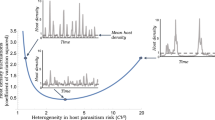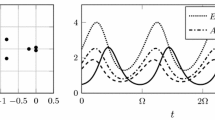Abstract
Observations of a host-parasitoid interaction in which victims are significantly less motile than their exploiters suggest the possibility of stable spatial pattern in a fairly homogeneous environment. Findings of pattern formation in continuous-time models are not fully able to account for this behavior. Those findings often rely on questionable biological conditions, and more fundamentally, the continuous nature of time in such models does not reflect the reality of the observed interaction. In this paper, we introduce a discrete-time spatial model of the interaction. The final state of our model is often a striking spatial pattern, similar to those observed. We analyze the model, describe its transient behavior, and find the conditions under which these spatial patterns occur, as well as an estimate of maximum possible patch size under those conditions. We also discuss the existence of such conditions in the natural system.
Similar content being viewed by others
References
Andersen, M., 1991. Properties of some density-dependent integrodifference equation population models. Math. Biosci. 104, 135–157.
Beddington, J.R., Free, C.A., Lawton, J.H., 1975. Dynamic complexity in predator-prey models framed in difference equations. Nature 255, 58–60.
Comins, H.N., Hassell, M.P., May, R.M., 1992. The spatial dynamics of host-parasitoid systems. J. Anim. Ecol. 61(3), 735–748.
Conway, E.D., 1984. Diffusion and predator-prey interaction: pattern in closed systems. Res. Notes Math. 101, 85–133.
Harrison, S., Wilcox, C., 1995. Evidence that predator satiation may restrict the spatial spread of a tussock moth (orgyia vetusta) outbreak. Oecologia 101, 309–316.
Harrison, S., Hastings, A., Strong, D.R., 2005. Spatial and temporal dynamics of insect outbreaks in a complex multitrophic system: tussock moths, ghost moths, and their natural enemies on bush lupines. Ann. Zoöl. Fenn. 42(4), 409–419.
Hastings, A., 1997. Population Biology: Concepts and Models. Springer, New York.
Hastings, A., Harrison, S., McCann, K., 1997. Unexpected spatial patterns in an insect outbreak match a predator diffusion model. Proc. Roy. Soc. Lond. B 264, 1837–1840.
Keeling, M.J., Wilson, H.B., Pacala, S.W., 2000. Reinterpreting space, time lags, and functional responses in ecological models. Science 290, 1758–1761.
Kot, M., Schaffer, W.M., 1986. Discrete-time growth-dispersal models. Math. Biosci. 80, 109–136.
Kot, M., Lewis, M.A., van den Driessche, P., 1996. Dispersal data and the spread of invading organisms. Ecology 77(7), 2027–2042.
Lockwood, D.R., Hastings, A., Botsford, L., 2002. The effects of dispersal patterns on marine reserves: does the tail wag the dog? Theor. Popul. Biol. 61, 297–309.
Maron, J.L., Harrison, S., 1997. Spatial pattern formation in an insect host-parasitoid system. Science 278(5343), 1619–1621.
McCann, K., Hastings, A., Harrison, S., Wilson, W., 2000. Population outbreaks in a discrete world. Theor. Popul. Biol. 57, 97–108.
Mimura, M., Murray, J.D., 1978. On a diffusive prey-predator model which exhibits patchiness. J. Theor. Biol. 75, 249–262.
Neubert, M.G., Kot, M., Lewis, M.A., 1995. Dispersal and pattern formation in a discrete-time predator-prey model. Theor. Popul. Biol. 48, 7–43.
Owen, M.R., Lewis, M.A., 2001. How predation can slow, stop or reverse a prey invasion. Bull. Math. Biol. 63(4), 655–684.
Van Kirk, R.W., Lewis, M.A., 1997. Integrodifference models for persistence in fragmented habitats. Bull. Math. Biol. 59(1), 107–137.
Wilson, W.G., Harrison, S.P., Hastings, A., McCann, K., 1999. Exploring stable pattern formation in models of tussock moth populations. J. Anim. Ecol. 68, 94–107.
Author information
Authors and Affiliations
Corresponding author
Rights and permissions
About this article
Cite this article
Wright, R.W., Hastings, A. Spontaneous Patchiness in a Host-Parasitoid Integrodifference Model. Bull. Math. Biol. 69, 2693–2709 (2007). https://doi.org/10.1007/s11538-007-9236-7
Received:
Accepted:
Published:
Issue Date:
DOI: https://doi.org/10.1007/s11538-007-9236-7




